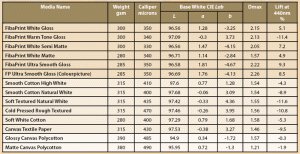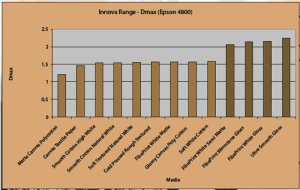articles/Paper/innovafineart-page2
Paper Chase - Innova Digital Fine Art Paper - part 2 of 1 2 3 4 5
by Mike McNamee Published 01/02/2008

The Dmax capabilities fall into three categories. The FibaPrint gloss and semi-gloss variants are all over 2; the matte papers are all around 1.5 and the matte canvas options are less than 1.5. All these values are both representative and expected for material of their class.

FibaPrint Warm Tone Gloss
The terminology 'warm tone' originally applied to chlorobromide silver papers which were usually laced with cadmium to control the grain size and toning properties. They were typified by Kodak Bromesko, Royal Bromesko, Agfa Portriga and Record Rapid. Most were initially modified to get around the cadmium problem (it was banned) then eventually dropped around the turn of the millennium. Another favourite was Kodak Ektalure which had a highly textured surface, a rich cream/ivory base and a warm tone coating. As late as April 2006 Ektalure was still being lamented on the web forums as 'the best paper ever'. With a single surface, a single grade and a distinctly low Dmax, it does not stand up to the historical (or should we say hysterical?) hype. To confirm our suspicions we dug some prints out, made in the 80s and ran them under the spectro alongside FibaPrint. To be honest Ektalure was a pretty indifferent, inflexible paper and even though it was jaw-droppingly expensive, your editor never even finished the box and gave it away. During our research for these older papers we came across the reported invention of baryta coatings, which occurred around 1866 and was originally intended to level out the fibres and protect the emulsion coating from the ravages of chemicals in the coarse paper base layer (end of history lesson).
Please Note:
There is more than one page for this Article.
You are currently on page 2
- Paper Chase - Innova Digital Fine Art Paper page 1
- Paper Chase - Innova Digital Fine Art Paper page 2
- Paper Chase - Innova Digital Fine Art Paper page 3
- Paper Chase - Innova Digital Fine Art Paper page 4
- Paper Chase - Innova Digital Fine Art Paper page 5
1st Published 01/02/2008
last update 09/12/2022 14:55:13
More Paper Articles
There are 57 days to get ready for The Society of Photographers Convention and Trade Show at The Novotel London West, Hammersmith ...
which starts on Wednesday 14th January 2026





